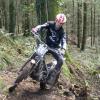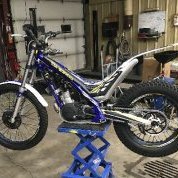-
Posts
999 -
Joined
-
Last visited
Contact Information
Recent Profile Visitors
|
14,958 profile views
|
-

So just what is so different about a diaphragm clutch
billyt replied to dan williams's topic in Beta
The above not withstanding. Diaphragm Clutch: Radial energy being converted into Axial kinetic energy being converted into radial energy and being converted back into axial energy a BIG factor in this equation. All the above just within the clutch cases alone. There is a lengthy article I wrote on a trials clutch about 32 years ago on the original "Trials Action" Ian Johnstone site (the prior name to this site). Maybe I can find it and re-post it. Now where is my Tandy TR80 or my Commodore PC ? -
Hi Dan.... Mount S3 pegs on Beta and play with moving them back and forth. Spilt the ergonomics between bars and pegs to get the best personal settings. Less impact on front steering and rear traction. Tune to taste 😎
-
Foot pegs in rear position with bars in original location you mentioned tried first ? Open up the riding cockpit ...
-

So just what is so different about a diaphragm clutch
billyt replied to dan williams's topic in Beta
Mmm Interesting 😎 -
Bri. Southern Arizona is a BIG place. Where are you thinking of spending winters in AZ ? Our trials group lives and rides in the greater Phoenix area. PM me for more info
-
No need to torque the top fork caps. Once you tighten up the top triple clamps Allen heads they will keep the fork caps in place. Hence why you have to loosing the top Allen head screws before you attempt to loosen the top fork caps.
-
Same here Jimmy 42 years of riding only trials bikes. Several Montesa 4T Scorpa 4T Beta 4T and many Beta 2T trials bikes We all have our experiences and that is good overall for the sport that we share them 👍.
-
Right off the Montesa manual. Pulser coil (Trigger coil)
-
Jonnyc21. My bad I should have said ECU not CDI. The Montesa does have a standard AC alternator (USA verbiage vs UK verbiage) . It also has an AC "pulser" (see attached Montesa schematic) or trigger coil beside the alternator. While the alternator is making AC voltage the pulser AC coil (trigger coil) is telling the bike when to fire (adjusted by the ECU & CDI box etc. When the bike is running pulling the lanyard sends a ECU pin to ground telling it ignore the Pulser (trigger coil and does not send signal to the CDI box and high voltage coil. When the bikes running and in gear when you put too much load on the back wheel at low rpms it stalls the engine. When the bike stalls the AC trigger coil no longer ses a rotation AC pulse going in the ECU box so it kills the bike. This scenario can be the same on a 2T carbed trials bike. Too low an RPM in gear and a heavy sudden load can cause a mechanical stall of the bike as it does not see any AC voltage coming from the alternator and pulser trigger coil to the ECU unit. I still think it is weird logic Jimmyl is stating. I do agree stopping the bike I gear with the clutch is a bad thing to do but purely from a mechanical stress level.
-
Just chocked on apiece of popcorn when I read your latest logic 😂 A stop is a stop regardless to the CDI box. If the lanyard is pulled the CDI box signal is taken to ground and stops the bike regardless of crank and piston position. If the bike is stopped via the clutch the lack of a magneto pulse signal from the pick up coil is missing so it stops the bike. In either scenario the full injection system I still under pressure and piston and crank will stop at a random part of its stroke. Your are entitled to your logic I am also entiltied to mine and I don't buy your logic No foul, no worries, just opinions.
-
Now I am even more confused. If you stop the engine vie the kill switch or lanyard how does that sequence the engine as it is totally random from a 4 cycle position of the engine? The engine will die and coast to a halt regardless of its rotational sequencing and its final position in the 4 cycle is totally random to the mass, gearing and rotational speed when stopped Are you saying when you stop the engine with the stop switch or lanyard the CDI box decides what position in its cycle to stop the engine at ??? To do that the CDI box would have to have a sensor telling the CDI box the pistons position or the cranks position. Even then how could it stop the rotating mass that preciously? Total agreement that from a mechanical stress on the engine perspective killing the bike with it in gear is not a good idea. I am more curious about Jimmyl's comment in how it stops the engine in the correct sequences. Please educate us in what that means? I will grab some popcorn 🥺
-
Jimmy. Can you please help us understand why " Stalling the bike with the bike in gear vie the clutch" is a bad thing ? Thanks....
-
A thumb throttle on a EM motion is an accident waiting to happen. We should be encouraging experimentation as it takes the sport of trials forward. We should also respect those people and ideas that came prior and learn from of it Everything comes around full circle as there is nothing really new and earth shattering to-date. Like in the past the "thumb throttle" conversation will have its moment, debate experimentation will ensue and then slip into the long list of "what ifs". Its all good stuff and keeps experimentation alive.
-
This question has been brought up and tried several times though the years. A standard Throttle tube twists towards the rider, and the front brake activates in the same direction A Thumb throttle pushes AWAY from the bars and the front brake pulls towards the bars. The latter is VERY hard to do and control with any fitness on a trials bike especially at the higher levels Keeping the front brake covered with one or two fingers at all time whilst keeping your thumb on a thumb throttle leaves very little of your hand actually holding the bars It is also tricky to do full lock turns with a thumb throttle as your thumb is extended out. Hence why it has not been adopted Go try it out for your self. I guess it is the "Thumb Throttle" idea time for recycling again. I applaud the tthought process though. 😎








